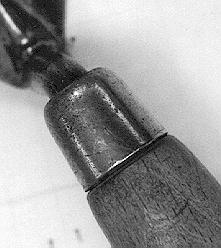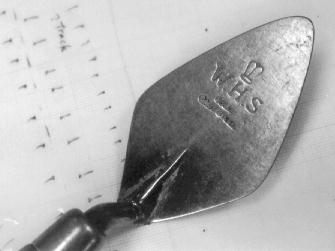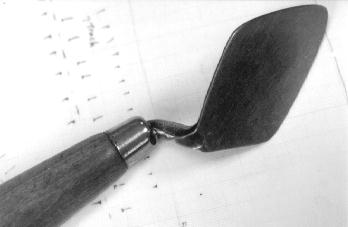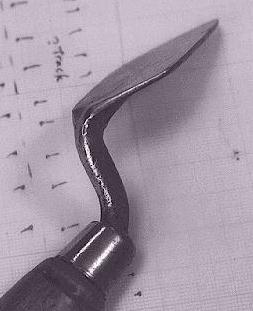
Please be patient; these images may take a few minutes to load.

WHS HISTORY
WHS was originally started in 1793 and the initials stand for William Hunt & Sons of Brades Steel Works. They were acquired by Brades Nash Industries in 1951 who were themselves acquired in 1962 by Spear & Jackson. Finally in 1985, Neill Tools purchased Spear & Jackson and inherited the WHS name. In the building trade, the WHS initials are affectionately referred to as "Work Hard or Starve".
Today, Neill Tools are the owner of the WHS brand name, and they are the largest British-owned hand tool manufacturer, with its world wide headquarters in Sheffield and a further plant in Birmingham. They also have offices in the USA, Australia and New Zealand and employ almost 2000 people, exporting to 118 countries on every continent operating under the major brand names of Spear & Jackson and Eclipse.
The brand leading brick and pointing trowels are roll-forged in Sheffield from one solid piece of metal, a skilled job and one which is little changed since it first began so many years ago. Despite technological advances, it is still very much a hand crafted product with heavy reliance on the skill of the operator to roll it correctly.
Despite roll-forging being labour-intensive, it is still the most cost-effective method of manufacture for the required quality level. The name Spear & Jackson now discretely appears below the WHS logo. In 1996, the contribution of trowels to British archaeology was acknowledged when Spear & Jackson sponsored the 20th bi-annual British Archaeological Awards, presented for the greatest initiative and originality in British archaeology. This year the award was won by Professor John Hunter from Birmingham for his pioneering work in forensic archaeology

Some live for the flexibility of a Marshalltown and some enjoy the style personified in a French trowel. We say nothing is more elegant than a sturdy WHS. We would like to share a few stories of trowels in action.
If you wish to share your trowel's biography, send it to assemblage

EMMA
"My WHS trowel and I first met the day I went off to university to study archaeology. Along with a (small) hoard of Roman coins (bought just in case I never managed to dig any up myself), my Dad had purchased a sparkling new four inch WHS pointing trowel, after much discussion with the man in the shop about the 'right' sort of trowel to use to find ship burials, coin hoards and the odd votive deposit. For several years, it had a fairly quiet life, suffering only one hairy moment, when it looked as though Mike Parker Pearson had managed to bury it beyond recovery during the backfilling of a rather large hole. Fortunately, disaster was averted and I tripped over it lying on the baulk whilst wandering despondent and tearful back to the van.
Since then, it has acquired a taste for fine French wine and warmer climes, despite seeming destined to spend most of its time shivering on a housing estate on Merseyside. It became a bit worn out digging through the gravel of a small Roman town in Essex and prefers the softer loamy soils and fun-filled prehistoric archaeology of the Great Orme in North Wales. At the moment, it lies neglected, but not forgotten, at the back of a drawer, doubtless dreaming of fills, pot and pounders � just like me!"

VICKY
"My WHS trowel is about five years old, but has yet to see much active service as I usually work in Bavaria, a land where tools are sharp and WHSs' are frowned upon. It once discovered a fellow trowel, trapped in the previous year's backfill and the name on the handle is inscribed with a Neolithic flint blade. It is often used as a beer bottle opener, and in the past has also doubled as a window prop and (sadly) mouse beheader."


KENNY
"This trowel, an old-style WHS pointing trowel with stamped letters, was a replacement for my first WHS trowel, which mysteriously disappeared on the final day of an excavation in Syria. As I was not returning home before my next dig, a Greek friend kindly gave me this trowel, for which I am forever in his debt.
It has since seen active service in Cyprus, Israel, Scotland, Syria, Lebanon, France and England; it has scraped a few skeletons and turned up some trinkets (not to mention watched some briefs), but was perhaps most notably involved in the discovery of several thrilling ramparts in central France and Syria � including the excavation of what was considered at the time to be the earliest 'glacis' rampart known in the world.
Despite now having been in my service for almost 4 years, I must admit that it isn't very worn down. This is perhaps due to its experience of tickling mudbrick walls while excavating tells. And perhaps because I spend too much time with my hands in my pockets."


MARK
"My first WHS trowel cost eight pounds and started life in June 1991 in Dorset, England. It fulfilled its duties in the summer seasons of 1991, 1992 and 1993 including 3 peat sites which stained the handle. It went into full time professional service in May 1994 and was retired in January 1996 apart from special duties. This trowel has experienced extreme geological diversity. It has worked in Dorset, South Yorkshire, East Yorkshire, West Yorkshire, South Uist, Dyfed, Humberside in Bronze Age, Romano- British, Viking, Medieval, and Post medieval sites.
My second WHS trowel was a gift from CADW in July 1993. It came into full time service in January 1996 and it is rapidly approaching retirement after 12 months of full time scraping. They just don't make trowels like they used to! Its C.V. includes work in South Yorkshire, West Yorkshire, South Uist, and Dyfed at Bronze Age and Post medieval sites."

JENNIE
"This WHS trowel was bought a couple of years ago after my first one got stolen. I bought it for a Greek dig, but when I got there, no one knew where the site was or had got a permit to dig, so I barely used it. Even so the handle has cracked, hence the plaster!"


JAMIE
"This is my second WHS trowel that replaced a previous one which I lost on a rubbish site (a "rubbish site" not actually a rubbish site!) in Hampshire in 1991. Its first outing was in Spain later that year. Since then it has been restricted to mundane British archaeology, the highlight being the Hebrides, where it only saw sporadic action. The red shoelace was added last year because I feared losing my trowel in the midst of so many others at the West Yorkshire unit. I also thought it might be handy to "hang up" my trowel during the lean periods."

BILL
"This is my favourite trowel, and the one I've managed to hold on to for longer than a couple of years without losing or breaking it (oh, the embarassment of ringing up a cinema to see if the cleaners have found a trowel). You can see from the differential wear pattern that a left handed action may have been used and the necessary identifying marks suggest a high-level of competitive consumption. It was picked up on the day I arrived on the Auvergne Archaeological Survey in 1991 as another volunteer left it behind and guess what? It's not even a Sheffield-made WHS but a cheaper Japanese model! First it was motorbikes, then cars, surely the British trowel industry isn't also prone to Pacific Rim lowpaid sweatshop labour and globalisation of the world economy?
It's travelled well � France, Turkey, the Hebrides, St. Kilda, Sussex, the Peak District, Lincolnshire and Doncaster (where it survived a winter in a deep, circular, partly water-logged site that combined most of the elements of the Somme with It's a Knockout!). While travelling around the Hebrides with Mark Edmonds, it did seem to worry an East German hitch-hiker when she saw me use it as a culinary utensil � although it may have been when I made a penguin out of a banana that concerned her most. She said she'd make her own way soon after that."


KATHRYN
"Ah, my Marshalltown trowels. (Unquestionably superior to WHS, even to the casual observer. Just look at the elegant, modern lines of the handle. And you have to admit that "The Golden WHS" sounds like one of those abbreviations in the personals.) These trowels have been to more interesting places than I have. I inherited the little one ...so, OK, I nicked it, but it was in a big pile of unloved trowels looking woebegone. (And it didn't have initials carved in the handle, which of course meant that it was fair game.) I don't know its history, but there were curious scorch marks on it when I first got it. Hmm. The bigger one I came by honestly, though the salesman at the building supply store couldn't understand what a 16-year-old girl was doing acquiring such a thing, and made some creatively indecent remarks.
A friend borrowed them to take to Egypt a while ago because she didn't have her own trowel but needed credibility. When I got them back, they were rusty. Horror! I still haven't managed to get all of the rust off, and am not sure whether to forgive her for so mistreating them.
My trowels have been loyal companions on salvage excavations of prehistoric native sites in Ontario, in amongst road planners, and at the reconstructed Jesuit misson village of Ste. Marie- Among-the-Hurons in amongst costumed historical interpreters. Both situations were hazardous. Then there were the day field-schools for nine-year-olds... I think I've finally got all the blood off them. My trowels have also seen duty at some rather amusing Canadian historic sites, including the scene of a rather inept and ultimately ill-fated American invasion of Ontario in the 1830s. The bigger one was the main instrument used in recovering old dandruff shampoo bottles from the backyard of the house where Dr. Norman Bethune was raised. It's not a particularly major tourist site for most people, but you should have seen the excitement of the many Chinese visitors every time we pulled out a piece of whiteware. He's still a major hero to them.
Lately, my trowels haven't been getting out enough, but sit patiently in my field bag at the bottom of my closet, hoping that this theory thing is just temporary. I don't know what to tell them. I just keep promising to sand the rest of the rust off soon."

JO
"I found this trowel in a little hardware shop in Bakewell several years ago and it took me digging on a Roman Fort excavation in Castletown, West Yorkshire for two years full time, then on occasional rescue excavations in the same town over the next three years. It was also used on a number of other short excavations, such as trying to find the nunnery at Nun Appleton near York, the Tanners Row site in Pontefract and in cleaning and clearing gravestones in a church outside Wakefield, where we were prayed for by the vicar during a service (much to our embarrassment). Much of this work was cold and wet, shifting ice and snow in the winter and pumping out or spraying the site in summer.
Since coming to Sheffield, it has travelled with me to Roystone Grange, working on Wigber Low, a Roman farmstead, medieval field boundaries and later period structures in the area, and to the Hebrides, where it supervised the departmental excavation of a putative shell mound and razed church.
During our vacation periods, it took me to the Whitwell Quarry cairn site for a summer, where we were competing with the quarry owners to see who could shift the most material (they did not know that we were dumping some of our rocks into their site, but they won in the end!). It has also taken me to Steinheim, near Frankfurt in Germany for the summer where we worked on a medieval castle site tracing the exterior walls and finding a tower base. We had plenty of local delicacies, sight-seeing and even learned some German! We had a short visit to Berlin, but were not allowed to chip any of the wall.
Since then, there have been a number of small excavations and other activities that we have been involved in, but my trowel is always ready to go given the opportunity. It has worked on all kinds of material from sand to stone and has always served me well, although it is getting a bit damaged and stained these days."


JONATHAN
"This 4 inch WHS was bought to replace the 6 inch WHS bought in rather embarrassing error just before my first year field trip (I had no idea what size they were supposed to be!). The larger trowel has gone on to do sterling service in the sands of the Hebrides which is about all it's good for. The 4 incher is quite well-travelled (France, the Czech Republic, the Outer Hebrides and a number of English sites between Surrey and Cumbria) but to be honest, not well used. I have often ended up spending much of my time on digs planning, my trowel remaining tucked into my back pocket or acquiring an interesting patina rattling around in my bag. At one time it had a string loop through a hole drilled in the handle, which allowed me to twirl it in a manner ideal for irritating supervisors (advertising my inactivity!). This was discarded when I actually started using the trowel for a decent length of time as it was really a bit annoying then as well! It does, however, have the honour of having trashed a number of interesting finds and features, including removing a chunk of the head of a very nice Gallo-Roman baby burial in the Auvergne and reducing a small piece of Hebridean pottery (of uncertain date) to an interested ochre smear (not particularly impressive, but that represented half of the total finds from three weeks excavation!). Ironically, now that most of the on-site work I do involves taking photographs, I've discovered that I really quite enjoy a good burrow, so now I have to skive off to use it!"

GERRARD
"Salut. I first came across my diggairr when I was excavating en my nativ France. 'E arrived in Soissons avec un trowel for gardening� ze silli Amercain boy� and my previous French boy, he present mi to zis green Americain fellow. Eez verri verri generous, no? Since zat time, I 'ave 'ad much travelling and excavated in mani different places� l'Etats-Unis, l'Angleterre, la France et l'Italie, but I prefairr to dig en Europe, where I can meet ozairr European artefacts (ze Americain artefacts pre'istoire, ze rarelie speak to mi). 'Owevairr, my Americain boy, although 'e 'as little culture, 'e iz verri verri friendlie to me and talks to me verri much, especialie aftairr a long day in ze sun. When 'e is supervisor, 'e often waves to othairr diggairrs avec mi. Also, I prefairr to dig ze 'istorique sites. (Zis word 'istorique is une expression difficile avec mani mani different meanings, I onnerstand. Neverzeless, I treat my Americain fellow verri well so zat I will nevairr have to become une 'andmaiden to 'istoire.) I excavate first my native soil avec zis Americain fellow, at a monasterie Augustinian en France, where I met mani mani artefacts� medieval coins, dead monks and barbed-wire, par example. Once, when we work for ze Oxford unit en Angleterre, I met zis sexy Anglo-Saxon leathair boot (who had lost 'er Welsh girl mani mani centuries ago). It was in Oxford, excavating near ze Thames, zat I learn to swim. Ze most boring work I 'ave 'ad was at zis famous site in East Anglia, where I scrape back endlesslie ze spits of Neolithique soil� une landscape of crude old flints. Like mani mani othairrs, I 'ave opened mani beerbottles and layed a few bricks (since I am now at l'universite, zis I must say to maintain my 'ard pose as a male working-class trowel). Always we 'ear of 'ow ze English WHS are different et superior, but, although my point 'as dulled and greyed with age and I 'ave 'ad une accident which required ze surgerie avec epoxie (even now I must wear ze electrician's tape girdle around my frog), I 'ave managed, avec ze 'elp of my boy, to stay fit. I would like to retire to ze Carribean, where I could dig for pirates. Thankyouverrimuch."
| TABLE OF CONTENTS | ABOUT US | RESEARCH PAPERS |
|---|---|---|
| FEATURES | NOTES FROM THE FIELD | REVIEWS |
| WORDS OF WISDOM | FORUM | THE FUN PAGES |
| ASSEMBLAGE NO.1 | EMAIL US | ASSEMBLAGE INFO |
�Matt Lemke 1997
Photographs �Jonathan Bateman 1997
�assemblage 1997